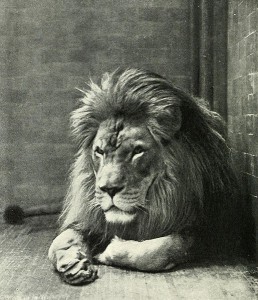
Sultan the Barbary Lion, hunted for captivity at the New York Zoo.
Big game hunting implies that a hunter is in pursuit of the most dangerous “big game” in the area. Africa’s “Big Five” are elephant, rhinoceros, Cape buffalo, lion, and leopard. American big game animals are bears, moose, and bison. Tigers and rhinos are the big game hunted on the Indian subcontinent. People seek the thrill associated with hunting the most dangerous animals, according to the owner of a Zimbabwean business that caters to big game hunters. In 2012, two hunters were killed by Cape buffalo, which means that more people were killed by champagne corks than Cape buffalo that year.
There are clear connections between contemporary white hunting in Africa and European colonialism. Tourists on safari are likely rich, white, male, of European descent.
“Really, I would be ashamed of myself sometimes, for I felt as if I had all the fun,” Theodore Roosevelt once said. “I would kill the rhinoceros or whatever it was, and then they would go out and do the solid, hard work of preparing it. They would spend a day or two preserving the specimen while I would go and get something else.”
Not much has changed since Roosevelt’s era in that respect. Local employees (who are usually black) do the exhausting dirty work before and after the kill has been made. Cecil the lion and the defunct colony of Rhodesia (now Zimbabwe) were both named after the British imperialist Cecil Rhodes.
Big game hunters once received incredible adulation. Ernest Hemingway was a writer synonymous with swaggering machismo and big game hunting. He was described as “this rumbustious man of action, this bullfighter, deep-sea fisherman, great white hunter, war hero, gunslinger and four-times-married, all-round tough guy, whom every red-blooded American male hero-worshipped.” For his era, apparently, those qualities mean he was the ultimate man’s man and someone to be emulated and respected. More recently, the media and the popular western perspective toward big game hunting have changed. Hemingway would not be the man that all other men would try to emulate, and after four marriages, he’d probably owe too much alimony to afford the months on safari. Hemingway, much like his writing, could be terse on the subject. Prefer something more lengthy and labyrinthine? William Faulkner is the obvious go-to.
A wall with unblinking glassy-eyed animal heads does not seem impressive. It seems creepy and tragic. But a trophy hunter does not pay thousands of dollars so he can eat the dead game for dinner or keep the exploits to himself. The trophy and “hero pose” photos are evidence, reminders, and validation that he who has killed the trophy animal is the wrangler of danger and the master of his domain.
Traditionally, hunting has been a decidedly masculine pursuit. People who dislike trophy hunting and hunters (in general) can become apoplectic about about female trophy hunters. As an interesting counterpoint to trophy hunters like Rebecca Francis and Robyn Waldrip, consider a U.S. Army veteran named Kinessa Johnson. Johnson joined VETPAW (Veterans Empowered to Protect African Wildlife) as an anti-poaching advisor after she finished a tour of duty in Afghanistan. So … we have Francis grinning next to a dead giraffe, Waldrip espousing the pleasure of killing an elephant, and Johnson training an anti-poacher task force. The Internet definitely has a favorite.
Despite the passionate worldwide response to the death of Cecil the lion, the citizens of Zimbabwe have other concerns and a different perspective. Lions represent threats to the lives and livelihoods of rural Zimbabweans. Although Zimbabweans respect and revere the native animals, white hunters have killed lions for sport for hundreds of years. Cecil’s death was a major event primarily to people who live far away.
